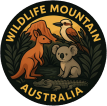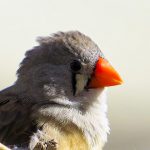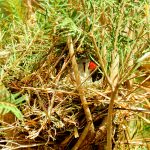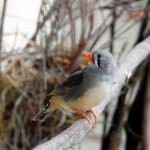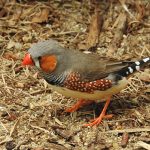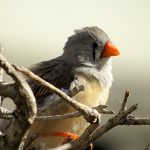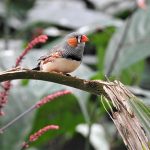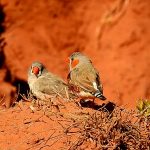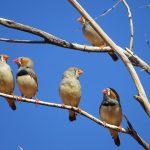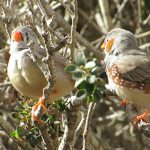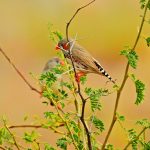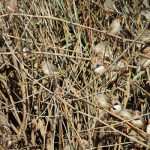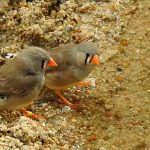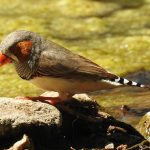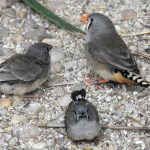ZEBRA FINCH
Zebra Finch
Among the sweeping grasslands and scattered woodlands of the Australian continent, a small, vibrant bird flits from perch to perch, filling the air with its cheerful chirps and musical trills. The Zebra Finch, instantly recognisable by the striking black and white stripes across its throat, stands as one of Australia’s most resilient and captivating avian inhabitants. Their adaptability, complex social lives, and the critical role they play in scientific discovery render them a species of enduring fascination and profound ecological significance.
This article explores the natural history, behaviour, ecology, and scientific importance of the Zebra Finch, revealing the multi-layered narrative of one of Australia’s iconic songbirds.
Natural Range and Habitat
The Zebra Finch’s distribution tells a story of endurance and flexibility:
- Geographic Range: Found throughout most of Australia, with the exception of the far northern tropics and the most arid desert interiors.
- Preferred Habitats:
- Open grasslands, where tall, swaying blades offer shelter and food.
- Savannas and shrublands, filled with acacias, eucalypts, and native grasses.
- Modified landscapes, such as farms and urban edges, where they sometimes nest in roof eaves or garden shrubs.
These broad habitat preferences underscore the Zebra Finch’s capacity to thrive across diverse Australian landscapes. Close your eyes and imagine: the warm scent of dry grass at dawn, the gentle tinkling of seed pods in a breeze, and high above, the rapid, excited chorus of Zebra Finches greeting the new day.
Sexual Dimorphism and Identification
A closer look at the Zebra Finch reveals delightful differences between the sexes—a phenomenon known as sexual dimorphism:
| Feature | Male | Female |
|---|---|---|
| Beak Colour | Bright orange-red | Lighter orange |
| Throat Markings | Distinct black-and-white stripes | Often plain grey |
| Cheek Patches | Vivid chestnut-orange | Absent |
| Flank Spots | Chestnut with white dots | Not present |
| Overall Plumage | More vibrant | Subtly patterned |
These contrasting plumages play a role in courtship and social interactions, allowing for quick identification of mates and rivals within bustling flocks.
Social Structure and Communication
Zebra Finches are not solitary wanderers; their lives are intertwined with the rhythms of the flock:
- Flocking Behaviour: Often seen in groups that ebb and flow like living clouds across the landscape.
- Vocal Communication: Their songs and calls, ranging from soft peeps to complex melodies, form a constant backdrop in the outback.
- Social Bonds: Within these groups, finches engage in mutual preening, sharing food, and intricate dances that reinforce social cohesion and partnership.
Their avian society is rich in acoustic texture—the soundscape alive with rapid-fire duets, contact calls, and even moments of silence that speak to their well-developed social intelligence.
The Art of Courtship and Cooperative Breeding
Mating among Zebra Finches is both performance and partnership:
Courtship Rituals
- Males sing elaborate, variable songs, sometimes mimicking the calls of neighbouring bird species.
- Dance routines include bobbing, hopping, and tail-quivering, with males displaying their brightest plumage.
- Pairs engage in mutual preening and gentle bill-touching, demonstrating a bond that extends beyond simple mating.
Nest Building and Parental Care
- Finches construct small, dome-shaped nests in tree hollows, thick shrubs, or man-made crevices.
- Both parents participate in creating the nest, often using grasses, feathers, and other available materials.
- The breeding pair shares incubation duties and, upon hatching, both mum and dad feed the rapidly growing chicks a mixture of regurgitated seeds and protein-rich insects.
This strong cooperative breeding behaviour is central to their survival strategy, ensuring that broods are well-provisioned even in fluctuating conditions.
Diet: Seeds, Insects, and Adaptability
Zebra Finches are primarily seed-eaters, their small, robust beaks perfectly adapted for husking even the tiniest of native grass seeds. However, their menu expands when chicks are in the nest:
- Seeds: The staple food year-round, garnered from native grasses and, occasionally, introduced pasture species.
- Insects: During the breeding season, adults seek out small insects and larvae to provide the necessary proteins for growing chicks—an example of dietary flexibility tightly linked to reproductive success.
In the bustling landscape of the Australian bush, the scent of drying grass seeds mixes with the subtle odour of damp soil after rain—a world of abundance for these resilient birds.
Vocal Learning and Scientific Significance
Beyond their ecological role, Zebra Finches have earned global recognition for their contributions to science:
Vocal Learning
- Song Development: Young males learn their songs by listening to and imitating adult tutors, a process that mirrors aspects of human speech acquisition.
- Song Plasticity: The ability to mimic sounds, especially in males, makes them both a marvel to observe and a model for research.
Scientific Studies
- Zebra Finches are the model organism of choice for studying:
- Neural mechanisms of learning: Scientists examine brain structures and pathways involved in song acquisition.
- Behavioural ecology: Studies on pair bonding, social learning, and communication originate from observing finches both in the wild and under controlled laboratory conditions.
- Their mnemonic repertoire, adaptability, and robust nature make them invaluable in understanding the broader mysteries of learning and brain function.
Ecological Role
- Seed Dispersers: By feeding on, transporting, and excreting seeds, Zebra Finches help maintain grassland health.
- Insect Control: Consumption of insects during the breeding season aids in keeping pest populations in balance.
Conservation Status
Currently, the Zebra Finch is considered secure across its range, thanks to its adaptability and broad habitat use. Nevertheless, continued vigilance is important:
- Emerging Threats: Habitat alteration, land clearing, and climate change could impact food availability and breeding sites.
- Conservation Message: The story of the Zebra Finch reminds us how interconnected life is—how the fate of a small songbird can reflect the health of an entire landscape.
The Australian Zebra Finch is more than just a splash of colour amongst the grasses. It is a living testament to the power of adaptability, cooperation, and communication. Its cheerful song not only enlivens the outback dawn, but also guides scientists as they unravel the complexities of learning and memory. In every thrum of wings and chorus of song, there is a reminder: by protecting these birds and their habitats, we preserve not just a species, but an intricate and beautiful chapter of the Australian wild.
References
- Clayton, D.F., & Mello, C.V. (2013). The Zebra Finch as a Model for the Genetics and Neurobiology of Vocal Learning. Cold Spring Harbor Protocols.
- Zann, R.A. (1996). The Zebra Finch: A Synthesis of Field and Laboratory Studies. Oxford University Press.
- BirdLife Australia (2024). Zebra Finch (Taeniopygia guttata) Species Profile.
- Australian Museum. (2024). Zebra Finch Profile. www.australian.museum
By fostering appreciation and understanding of species like the Zebra Finch, we unlock a deeper connection to Australia’s extraordinary wildlife and embrace our shared responsibility for its conservation.
